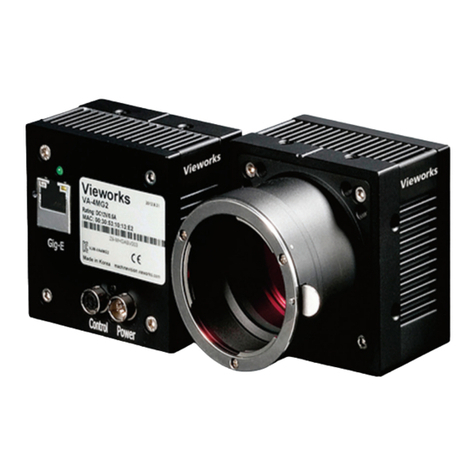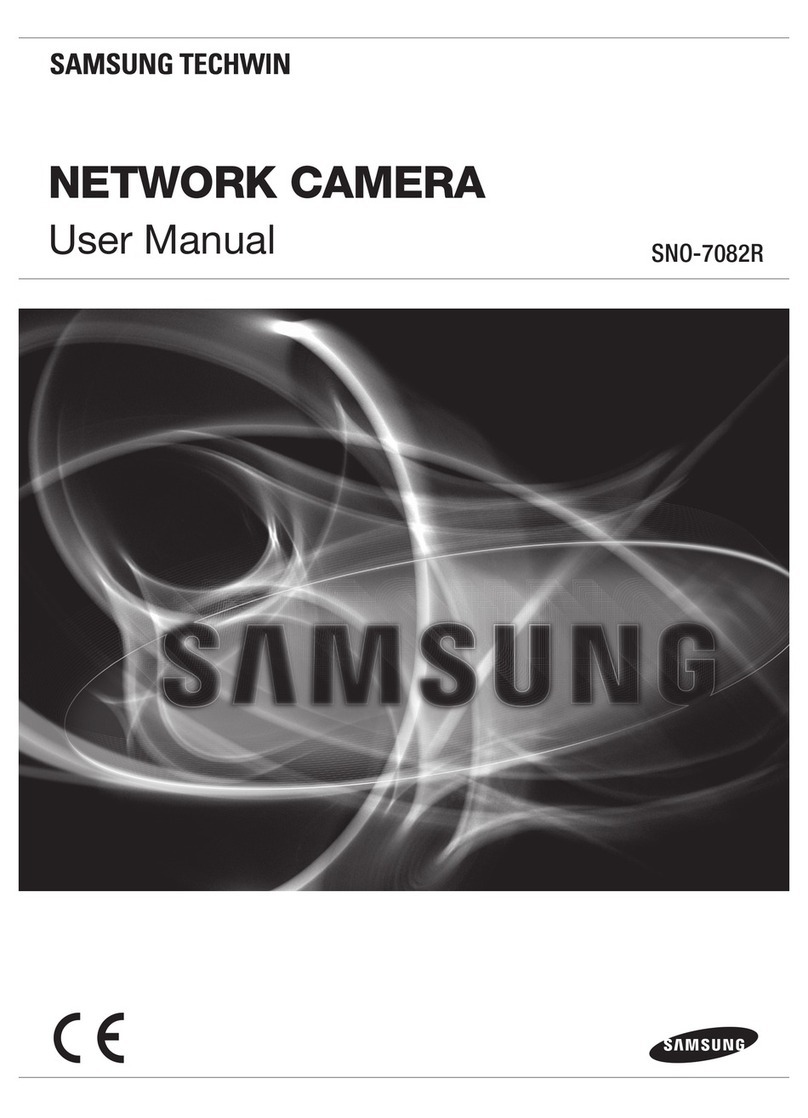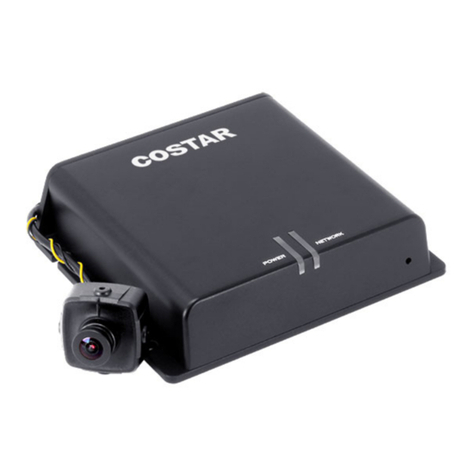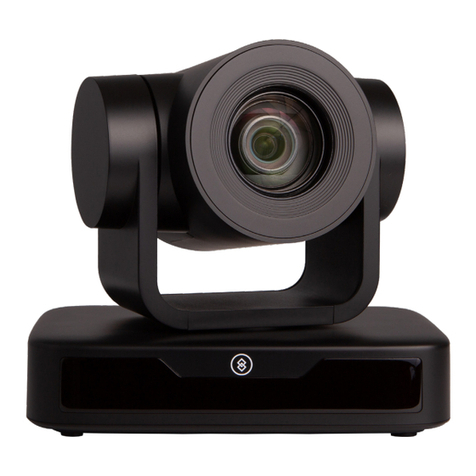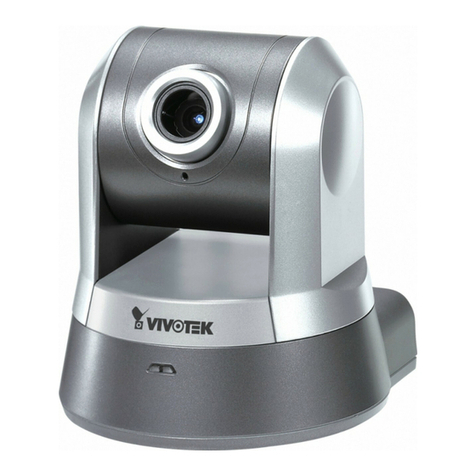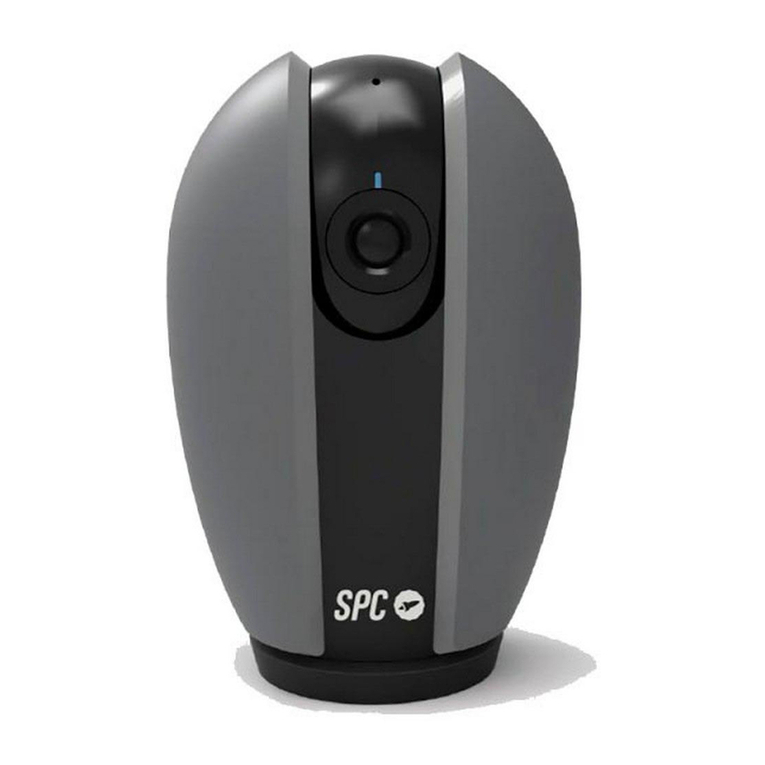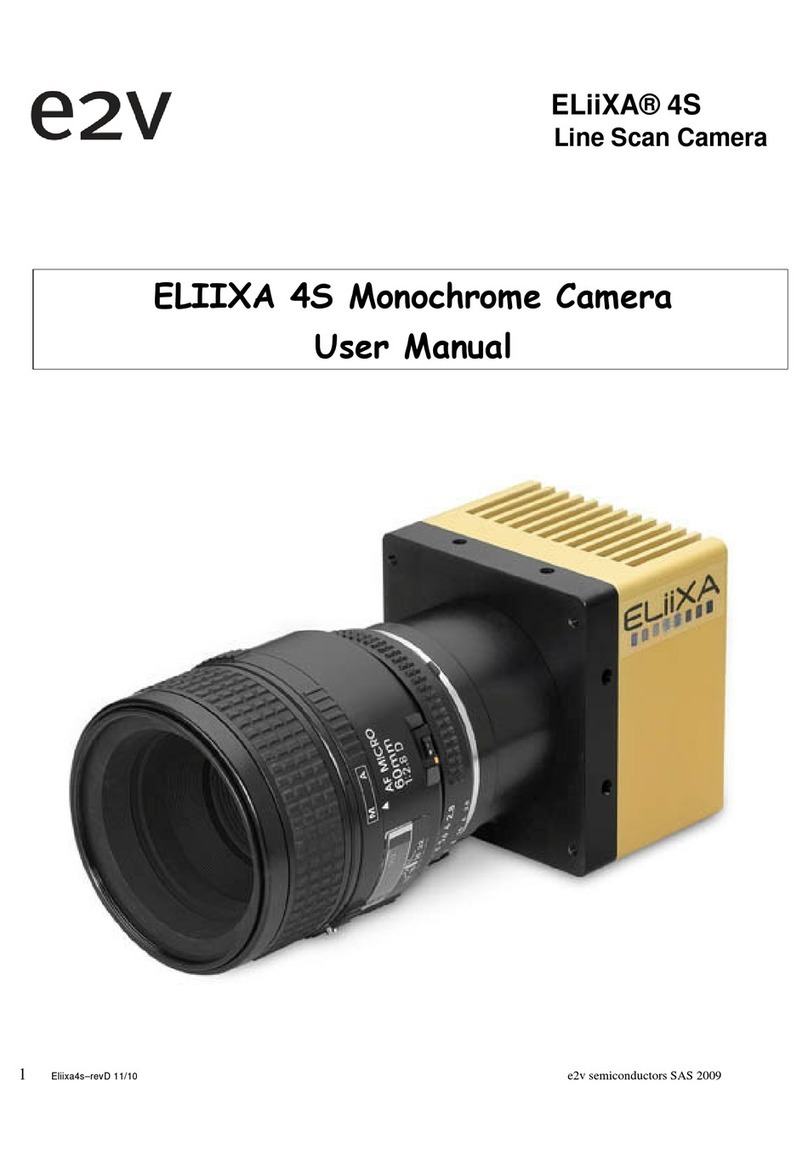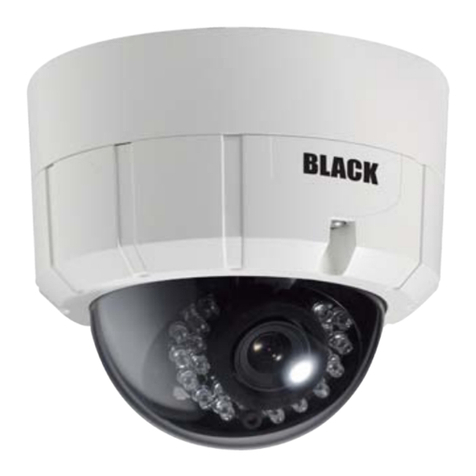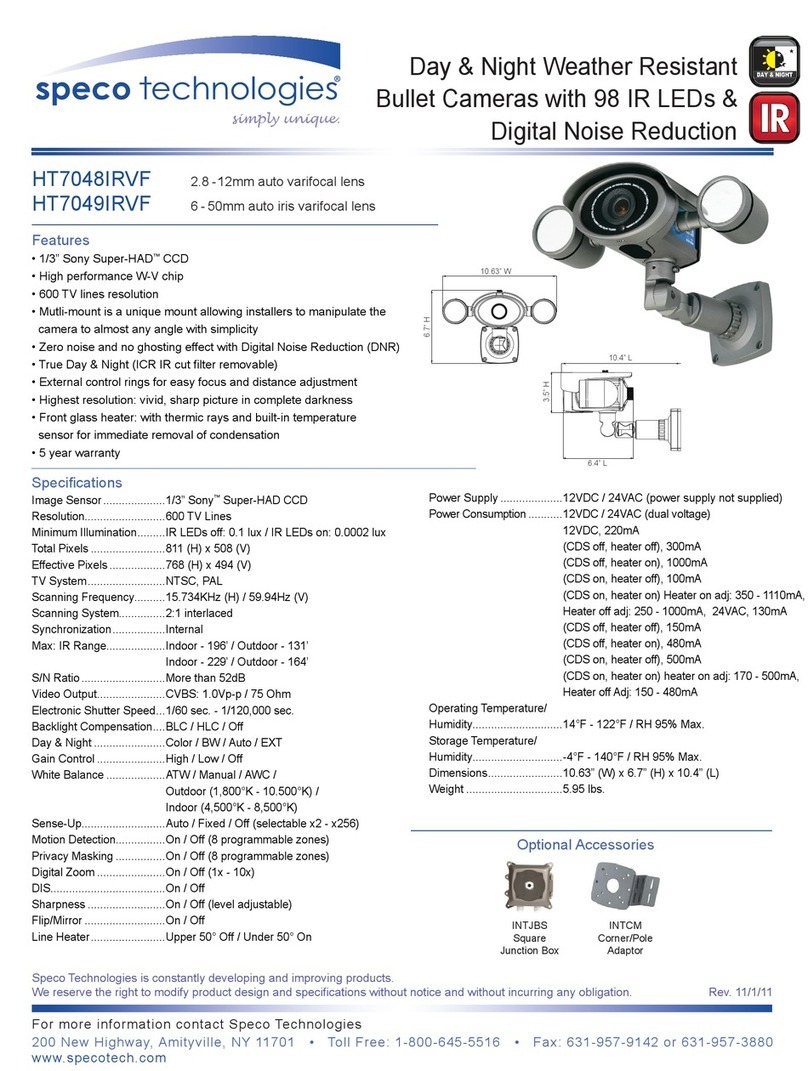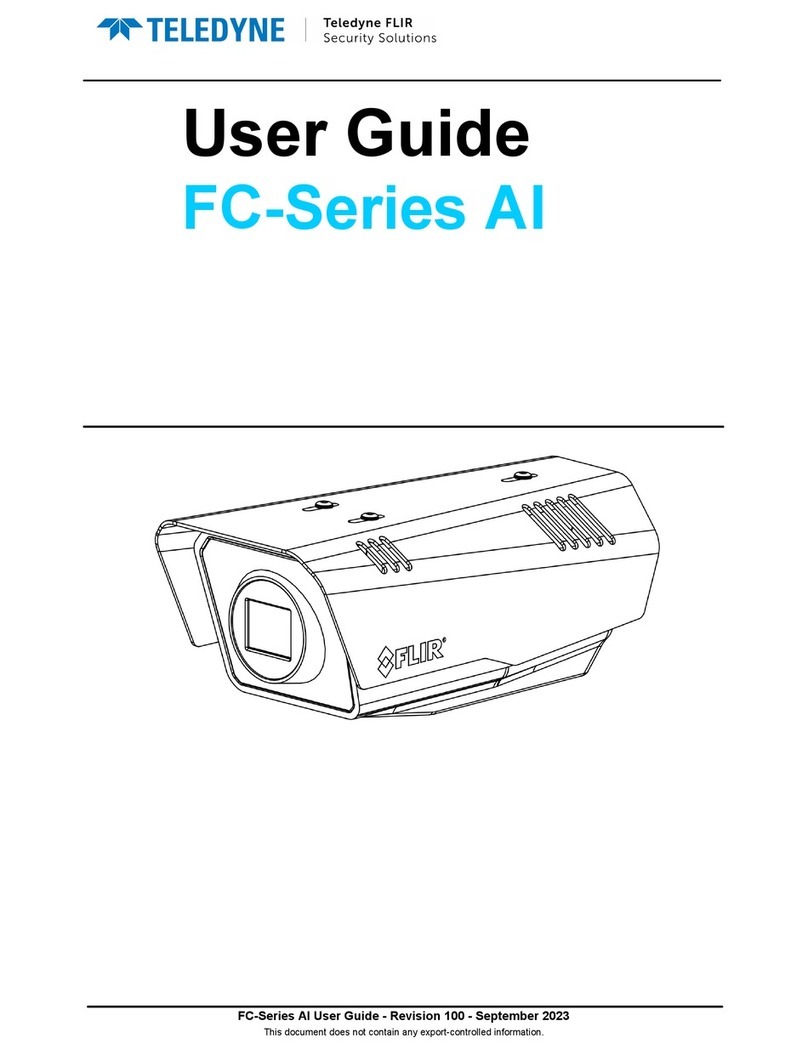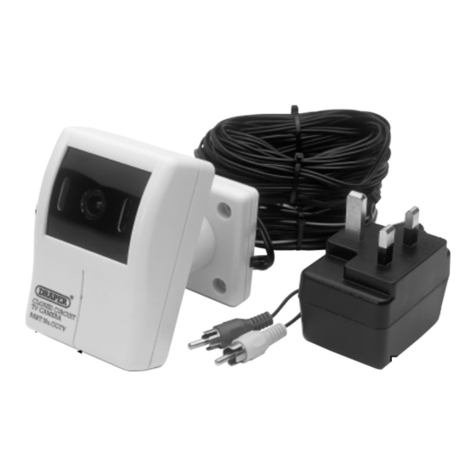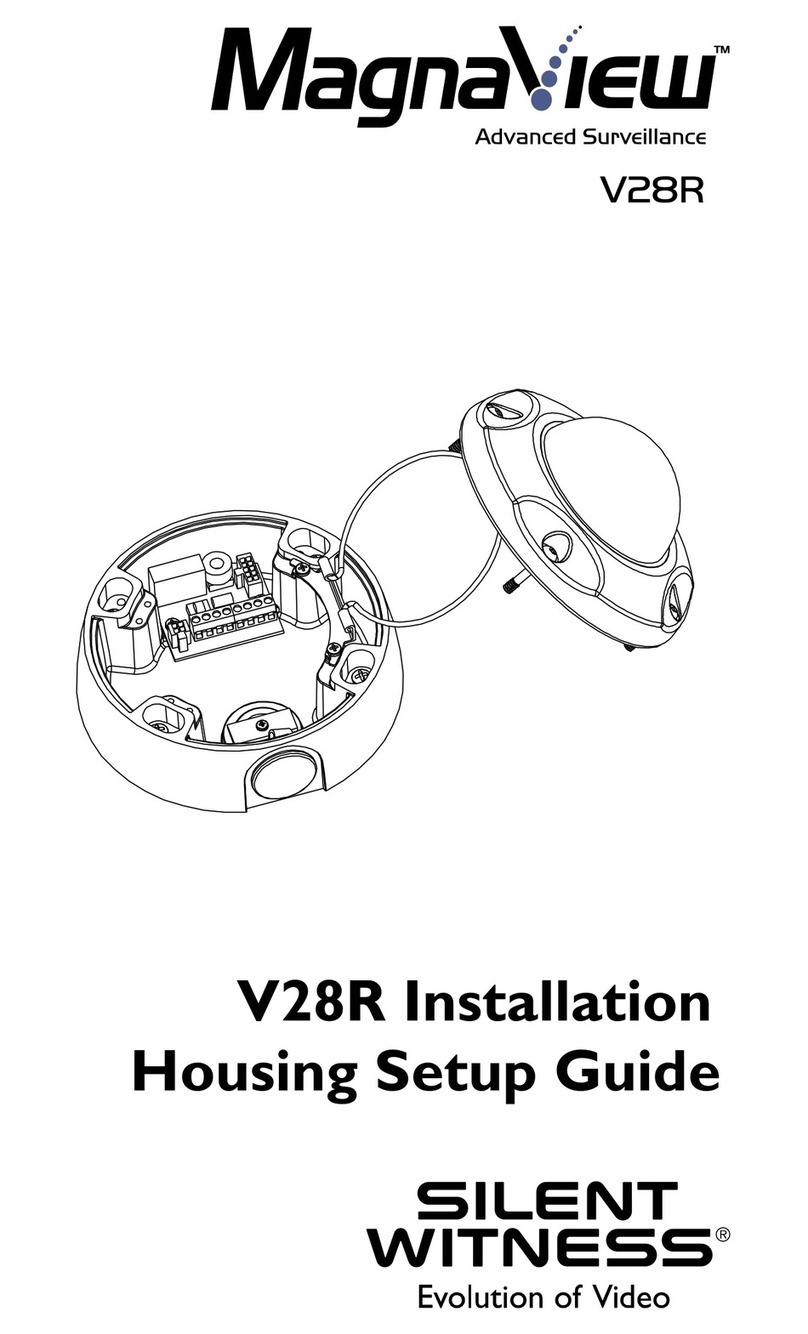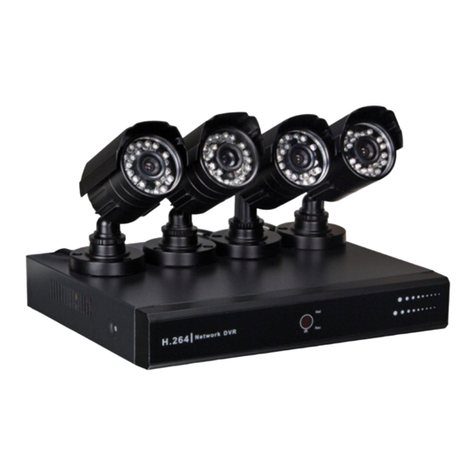GigE FC11000GE User manual

K09821;1/37
- 1 -
Video Camera
Instruction Manual
GigE Vision compliant
11 Megapixel Progressive Scan Monochrome/Color Camera
FC11000GE
FS11000GE
●We greatly appreciate your confidence choosing our TAKEX CCD Video Camera.
●Please read this manual and the attached guarantee certificate carefully and manage the camera properly.
Keep this manual at hand and reread it whenever you are uncertain about the operation.
Table of Contents
1.
Features······························································································ 3
2.
Outline································································································· 3
3.
Description of Each Component ······························································· 4
4.
How to Operate····················································································· 6
5.
Various Settings ···················································································11
6.
How to Change Settings·········································································14
7.
Serial Communication Command·····························································22
8.
Timing Chart························································································29
9.
Image Display Software andAPI terms ·····················································34
10.
Notes·································································································36
11.
Specifications·······················································································37
12.
External Dimensions ·············································································37
TAKENAKA SYSTEM CO., LTD
Document No.: K09821
FX11000GE Instruction Manual (4th version)

K09821;2/37
- 2 -
[History of revision]
Version Content of change Description Date Document
No. Remark
1
st
version
2009-04-08
K09408 FC11000GE
FS11000GE
2
nd
version
K09531
3
rd
version
K09713
4
th
version
K09821
Description of special remarks used in this manual
(Note)················Particulars which require the user’s attention are explained.
(!)················Particulars which require the user’s close attention in terms of comparison with the conventional
products are explained.
[Terminology]················Terms specifically defined for the purpose of describing the operation of this camera are explained.
[Explanation]················Particulars for which details may be needed for user’s understanding of the operation of this
camera are explained.

K09821;3/37
- 3 -
1. Features
●
FC11000GE/FS11000GE is a full frame shutter monochrome(FC11000GE)/color(FS11000GE) camera incorporated
with 11-megapixel, diagonal 43mm-size CCD image sensor .
●
A full frame shutter image can be obtained at a rate of 5 frames per second (in DUAL mode).
●
Gigabit Ethernet is adopted as the output interface of image signal.
●
Image signal can be output at 12/10/8-bit resolution.
●
The set values of the camera can be externally controlled with the use of the serial communication via Ethernet.
●
The character information of the current setting status of the camera can be superimposed over the captured image on
the screen. (On Screen Display function)
●
The monitoring function for measuring the internal temperature of the camera.
●
The asynchronous shutter is applicable both in the preset shutter mode and the pulse width control mode.
●
The camera is designed so that the strobe signal can be output even in the continuous shutter mode, and this
contributes to the power saving for LED lighting and others as well as the reduction of smear.
●
The ID information set by the user for each camera can be saved and read out whenever necessary ( via serial
communication link).
●
It is equipped with correction function that automatically reduces the difference between right image and left image.
●
FS11000GE is a color camera(Bayer, RAW output).
※
FS11000GE is not equipped with IR cut filter. If it has the coloring problem by the effect of infrared, use the camera with the
IR cut filter placing in front of lens.
2. Outline
CCD
DRIVER
P LDT G
CP U
A /D
( OFF SET )
Preamplifier
(GA IN)
UA RT
S /H
SYNC
V ini t
Camera Link I/F
Gigabit Ethernet
IP EN G IN E
RXD
TXD
V i n i t 1S T R B MO DE,EXP UD-SW
S /H A /D
( OFF SET
+ OFF SET _B)
(GA IN
+GA IN_ B)
PL D
DUA L&S ING LE
DUA L
R J -4 5 C on n ec to
Gi g E I /F
12/10/8 bit
DUAL out SINGLE out
Image sensor
Imaging area size
Number of pixels
Pixel size
CCD Image sensor: Monochrome/Color
36.07mm
×
24.05mm (Diagonal 43mm)
4008(H)
×
2672(V)
9.0
μ
m(H)
×
9.0
μ
m(V)
Effective pixels 10.7 megapixels
Read out
scanning
Horizontal
14.1 KHz 7.5 KHz
Vertical 5.1 Hz 2.7 Hz
Clock 32.50 MHz
Electronic shutter 1/2000 to 1/5 second
(Continuous shutter and asynchronous shutter)
Video output signal
Digital 12/10/8 bit
Gigabit Ethernet interface(GigE Vision compliant)
2Tap 1Tap
Scanning mode Normal scanning for all pixels
Double speed scanning
OB(Optical black)
E f fe ct i ve im ag e p i ck u p ar e a
4 0 08 x 26 7 2
V
S IN GL E
V ID E O L
4008
20
1 7
1 6
2672
H
12
8
4 19 413
V I DE O
2004 2004
8
Output
D UA L
or
B
RG
G
C olo r
c odi ng
Fig.2-1 CCD architecture
Fig.2-2 Block diagram

K09821;4/37
- 4 -
1.0
0.9
0.8
0.7
0.6
0.5
0.4
0.3
0.2
0.1
0.0 500400 600 700 800 900 1000
(Typ ica l v alu e )
FC11000 GE
1.0
0.9
0.8
0.7
0.6
0.5
0.4
0.3
0.2
0.1
0.0 500400 600 700 800 900 1000
Wavelength
(nm)
FS11000GE
( Not e)T he ch r c ter ist ics o f l ens ,lu min ous so urc e e tc . re lef t o ut of con sid er ti on.
Re lat iv e se n si tiv i ty
R el a tiv e s en s it i vi t y
Wavelength
(nm)
(Ty pic al val ue )
3. Description of Each Component
(3-1) Description of rear panel of camera
Panel to set up operation mode, electronic shutter speed and other parameters and to connect each output connector →Refer to
the diagram below.
POW ER
EX P. M ODE
U
DLE NS
1 0
11 1 2
9
8
7
6
5
4
3
2
1
1
2
34
5
6
Ca m er a c on n ec t or ( P OW E R ) I ri s c on n ec to r ( L EN S )
R ea r p a ne l
Ope rat ion ind ica tor
Link sp eed in dica tor
L ink sta tus in dica tor
RJ-45 LAN Connector
8 7 6 5 4 3 2 1
LA N co nne cto r
(3-2) Camera connector (POWER) (
HRS HR10A-10R-12PB
)
The pin arrangement of the Camera connector (12 pins) and the
signals assigned to those pins are shown in the following table:
Pin No.
Signal name
Description I/O
Pin No.
Signal name
Description I/O
1 GND (0V) Power ground
7 IC
2 +12VDC DC power input
(In)
8 GND Signal ground
3 GND Signal ground
9 IC
4 IC
10 GND Signal ground
5 GND Signal ground
11 STRB Strobe signal output
Out
6 Vinit1 Input for external trigger
In
12 GND Signal ground
* Do not assign any signals to the IC pins because they are occupied internally.
(3-3) Iris connector (LENS) (
HRS HR10A-7R-6SB
)
The pin arrangement of the Iris connector (6 pins) and the signals
assigned to those pins are shown in the following table:
Pin No.
Signal name
Description I/O
Pin No.
Signal name
Description I/O
1 NC
7 +12VDC DC power
(Out)
2 GND (0V) Power ground
(Out)
8 NC
3 IRIS Iris output
Out
9 NC
(Note) ”IRIS” is the false image signal output exclusively used for controlling the image signal input type-Auto iris lens
It is not possible to take out the normal image signal from this pin terminal.
Fig.2-3 Typical sensitivity characteristic
Fig.3-1 Connectors on rear panel

K09821;5/37
- 5 -
(3-4) Mode switch (MODE)
The Operation mode and Gain can be set by manipulating Mode switch and UP/DOWN switch.
(3-5) Shutter switch (EXP.)
The shutter speed (shutter exposure time) can be set by manipulating Shutter switch.
(3-6) UP/DOWN switch (U-D)
The Operation mode and Gain can be set by manipulating Mode switch and UP/DOWN switch.
(3-7) LAN connector (Standard type RJ-45 connector)
This is the LAN connector (RJ-45 type) conforming to Gigabit Ethernet interface (1000BASE-T/IEEE802.3ab).
It is connected with the LAN connector of PC using standard LAN cable(CAT-5e or CAT-6) conforming to Gigabit Ethernet.
[Pin arrangement of LAN connector (RJ-45)]
Pin No.
Signal name Description I/O
1 TP0+ Twisted pair 0 (+) In/Out
2 TP0- Twisted pair 0 (-) In/Out
3 TP1+ Twisted pair 1 (+) In/Out
4 TP2+ Twisted pair 2 (+) In/Out
5 TP2- Twisted pair 2 (-) In/Out
6 TP1- Twisted pair 1 (-) In/Out
7 TP3+ Twisted pair 3 (+) In/Out
8 TP3- Twisted pair 3 (-) In/Out
When using this equipment on a place subject to constant vibration or impact, it is recommended to employ a screw lock type
LAN cable. Firmly screw a locking screw into a connector fixing screw hole when using a screw lock type cable.
(3-4) Display LED
Three indicator LEDs are laid on the rear panel
・Operation indicator LED (POW: Three colors: green/red/orange)
It lights up (or brinks ) to indicate that the camera is powered.
When the camera is set in the asynchronous shutter mode, It lights up in red
in response to the input of the external trigger signal.
・Link speed indicator LED (SPD: orange)
It lights up in orange to indicate that the camera is connected to LAN port (LAN card) or HUB of Gigabit Ethernet
Interface (1000BASE-T).
It turns off when the camera is connected to LAN port (100BASE-T, 10BASE-T) of which communication speed is lower than
1000BASE-T or when the camera is connected to nothing.
・Link status indicator LED (LINK: green)
It lights up when the camera is connected to the other LAN port via Ethernet and the data-access is running as well.
Name
Color OFF ON Blinking
SPD Orange Disconnected from LAN
or Connecting at 10Mbps/100Mbps Connecting at 1000Mbps -
LINK Green Disconnected from LAN Connected to LAN Data accessing

K09821;6/37
- 6 -
4. How to Operate
(4-1) Connection method
●Connection
Refer to the connection example between the camera and
peripheral devices (Fig. 4-1).
(1) Remove the cover of the lens attachment section and
attach a lens (option).
(2) Connect the camera head to a power supply unit(option) with a
camera cable (option).
The maximum allowable length for camera cable is 10 m.
(3) Connect the LAN connector on the rear of the camera to the LAN
connector of PC through LAN cable(Cat-5e or greater).
The maximum allowable length for a standard LAN cable is 100m.
Also, the maximum allowable length for a hi-flex LAN cable is 30m.
(4) Turn on the power switch of the camera after
confirming the connecting condition.
In 1 or 2 seconds after the power is turned on,
the operation indicator LED on the rear panel of
the camera changes from orange to green to show
that the camera is in operation.
(5) Set the camera operation modes in accordance
with the setting instructions for the operation
modes and the shutter speed that are described
in another section.
(Note) The maximum allowable lengths of the camera cable and the LAN cable aforementioned are not for the purpose of
guaranteeing the operation of the camera. Proper image signals may not be obtained even when the cables are
within the allowable ranges, depending on the installation conditions of the camera, cables in use and others.
Especially for a camera cable (Power cable), the voltage of the terminal end on camera side is required to be within
a voltage range of the specification (12V±10%) with the camera being connected.
(Note) As the LAN card, use a separately recommended product or a LAN port equipped with recommended Ethernet
controller(PHY).
[Important]
(Note) Make sure to turn off the power switch of the camera before connecting or disconnecting the camera cable.
If the cable is connected or disconnected while the power is supplied, troubles may be caused.
(Note) Make sure to turn off the camera and connected devices in advance when the camera is connected.
(Note) When a power supply unit other than Takenaka’s camera power supply units that are separately sold is used, make sure
that it complies with the following rated specifications:
Power supply voltage: DC12V±10%
Current capacity: 1.2A or over (recommended value)
Take into consideration the fact that transient current of about 1.8A flows when power is applied.
Ripple voltage: 50mVp-p or less (recommended value)
Connector: 12 pin connector 1 pin (GND), 2 pin (+12VDC)
(Note) Some power supply units other than TAKENAKA’s products have different layout of power connection pins. Make sure to
check the compatibility of the power supply unit and the camera connection pins in advance.
Carefully note that any failure associated with power application to out-of-
specification pins and others is subject to
charged repair.
(4-2) Input of Vinit signal (asynchronous trigger signal)
●How to input Vinit signal
If the camera is used in the asynchronous shutter mode, the Vinit signal (asynchronous trigger signal) must be input
from the user unit.
The Vinit signal is input from Pin (6) of the “POWER” connector (12 pin connector) on the rear of the camera.
If the camera is connected to the power supply unit PU100 with a Takenaka’s 12W series cable, connect the Vinit
signal (asynchronous trigger signal) to the trigger input terminal of the power supply unit (PU100).
(Note) Though the asynchronous trigger signal can be given by serial communication command via GigE interface, it
is not suitable for real-time image capturing as it gets delayed following packet forwarding.
(Note) When the camera is in OSD menu displaying status (when the operation indicator LED blinks in green), periodic
trigger signal continues to be supplied from internal CPU so that OSD display is updated on regular basis.
In this state, the external trigger signal (Vint) can not be accepted.
Turn the OSD menu to hidden status to make Vint signal input effective.
Fig. 4-1. Connection example between
camera and peripheral devices
Computer
LAN card
(LAN portト)
Intel PRO/1000
etc.
Trigger pulse
generating circuit
(sensor etc.)
TRI
12W-02 etc.
LAN cable
(Ctat-5e,Cat-6)
P U 1 0 0
F C s er i es c a me r a
FCxxx E
T AKE X
Camera cable

K09821;7/37
- 7 -
●LED Vinit signal monitor indicator
When this camera is set in the asynchronous shutter mode, the LED indicator on the rear
panel of the camera lights up in red for one shot in response to the input of the external
trigger signal (Vinit signal).
This allows the user to confirm the state of signal input.
The red LED lights up for a certain period of time (for about 100 ms) each time for a
trailing edge of the trigger input. If a following trigger signal is input within this period, the
lighting time of the LED will be retriggered and extended.
Since the lighting of the LED responses only to the trailing edge of the
trigger input, it lights up only once for 100 ms even if the trigger input
pulse duration is longer than the one shot time of period.
●Setting of various asynchronous shutter modes
Set the parameters and others in accordance with the following table:
Table 4-1 Setting of various asynchronous shutter modes
Asynchronous shutter mode PWC Shutter switch Remark
Preset shutter (PWC=DISABLED) DISABLED
1 to 9
Preset shutter (PWC=ENABLED) ENABLED 1 to 8
Pulse width control 9 Shutter switch = 1 to 8: same as preset shutter
(Note) When shutter switch is 0, “Continuous image output(without shutter)” is applied for the all.
(Note) For setting methods for the respective parameters of “PWC” and others →See “ How to set operation mode”.
●Recommended timing of asynchronous shutter trigger signal (Vinit signal) for preset shutter/pulse width control
For the case of preset shutter mode
, the negative logic pulse is
applied within the width range from 1
H (1 horizontal
synchronous interval) to 40H as described below.
For this case, the exposure operation starts in synchronization
with the trailing edge of the applied pulse.
For the case of the pulse width control exposure mode,
numeric value of the L lev
el interval of the input Vinit pulse
(shown as Tvinit in the figure) is retrieved
in synchronization with
the trailing edge of the internal HD pulse
, and the integer
multiple number of H (1 horizontal synchronous interval
) that is
closest to the retrieved Vinit pulse duration
is transmitted as nH
to the inside of the camera. Then the shutter speed
is
determined in response to the time nH.
Vinit
Tvinit
[For the case of preset shutter mode]
1H ≤Tvinit ≤40H
(The exposure time is independent of the Vinit width.)
1H=1 horizontal scan time
[For the case of pulse width control mode]
(Where PWC=ENABLED, shutter switch = 9)
nH ≤Tvinit <(n+1)H (n is 1 or larger integer.)
(This is the pulse width where shutter exposure time =nH)
Fig.4-3 Vinit signal timing
(Note) In the pulse width control, the shutter exposure time is almost equal to the integral multiple number of the
horizontal synchronous time (H) that is closest to the Vinit pulse duration. More specifically, however, the
shutter exposure time is indefinite for the time period corresponding to 1H width in the case of normal external
trigger input (or the case where the Vinit signal is not in synchronization with the horizontal synchronous
timing of the camera).
→Refer to the timing chart described in another section for the details.
(Note) When the shutter exposure time is too long in the pulse width control mode, the S/N ratio of the image will
be degraded due to the reduction of dynamic range of CCD, accumulation of thermal noise components of
CCD image sensor in proportion to the shutter speed and other factors. Therefore, if a long exposure time is
employed, it is recommended to conduct experiments using realistic exposure times in actual conditions to
check for the appropriateness.
●Example of drive circuit for Vinit input circuit
* The Vinit signal should not include unnecessary noise components such as chattering.
[Input voltage range]
H level 2.5 to 5.5 V
L level -0.5 to 0.5 V
*
T
he voltage of the terminal end on camera side is required to be within the above voltage range with the camera being connected.
Red LED lights up in red in response
to trigger signal input (Vinit).
Camera
connector
75
Ω
6
Vinit1 IN
VCC
3.3V
4.7k
47p
3.3V
10k
100Ω
TC7 4LVX14 o r equivale nt
To internal circuit
3.9 ZD
VCC is +
5
V
or
+
3.3
V
74AC04 or
others
[Example of user circuit]
Inside of camera
GigE
Serial I/F
P OW E R
E XP . M O DE
U
DL E N S
Op era tio n in dic ato rLE D
Fig. 4-2. LED indicator
Fig. 4-4. Vint circuit

K09821;8/37
- 8 -
S T R Bs i gn al ou t put
( 11 )p i n o f Ca m er a c o nn ec t or
1 0 0Ω
F r om
i n te r na l c ir c ui t
74VHCT04A
+5 V
(
or equivalent)
6.8 ZD
STRB
BUSY
OFF
Fig. 4-5. Strobe signal output circuit
(4-3) Strobe signal output circuit
The internal output circuit is shown in the right figure.
●Conventional cameras used the strobe signal (STRB) as
the exposure timing signal only. In this equipment, this can
be switched between OFF, STRB signal (continuous &
asynchronous) and Busy signal(asynchronous) by setting.
This setting can be changed on the configuration menu
(Operation Mode Setting Group 3) or by way of rewriting the
configuration register with serial communication command.
The default setting is OFF (no strobe signal).
This equipment is capable of outputting the strobe signal even in the continuous shutter mode as well as in the
asynchronous shutter mode when the setting is changed to output the strobe timing signal(STRB).
[Explanation] Usage of strobe signal in continuous shutter mode
In the continuous shutter mode, only the incoming light for the time matching the exposure time of the camera is valid.
Accordingly, when a lighting unit is used in the continuous lighting mode, the lighting during the time other than this exposure time
period would be wasted.
Since this equipment is capable of outputting strobe signal (STRB) even in the continuous shutter mode, this output is used as a trigger
signal to control a LED light or other lighting units that can be turned on and off at high frequencies, which helps eliminating the lighting
during the useless lighting time.
The following benefits are derived from this type of lighting control:
●The consumption of the power to a light can be saved by way of lighting only during the valid time for exposure.
●The occurrence of smear is reduced because no light enters any time other than the exposure time periods.
(Note) When the strobe signal is used in the continuous shutter mode to make ON/OFF control on a lighting source unit,
the following must be taken into consideration:
Wherever possible, use a strobe lighting unit or others that are equipped with a power source separated from that
of the camera (electrically isolated power source) and a trigger input terminal (photo coupler input, etc.). If a
lighting unit that shares a power source or a ground circuit with the camera is turned on or off by the strobe signal,
the image output from the camera may have noise due to the influence of the fluctuation of the power supply
voltage or change in the electric potential that occurs at the ON/OFF timing.
Even when the insulation aforementioned is applied, the electromagnetic induction may lead to the occurrence of
noise on the image signal if the electric current of the lighting unit to be control is large. In this case, a measure
must be introduced to reduce electromagnetic induction noise arising from the lighting unit.
(4-4) Test pattern display function
When initially connecting this camera to an image capture board, the use of the test pattern display
function of the equipment makes it easier to confirm that the output timing of the camera and the
details of the signal connection match the particulars of the capture board.
When the test pattern function is set to be ON, the image sensor outputs the test pattern in place of
pictures as shown on the right.
As for this pattern, a numerical value of 1 is simply added in an incremental manner for every
horizontal pixel, and a saw-tooth profile is shown in the range from the numerical value of 0 to 1023.
(Note) In the data, a numerical value of 1 is incrementally added for every horizontal pixel in the
range of 0 to 1023 for the case of 10 bit output, and in the range of 0 to 255 for the case of 8
bit output.
(Note) The value does not start with 0 at the edge of the effective image area.
(Note) The output values of the test pattern are not affected by the values of the gain setting or offset setting of the
camera.
The default setting is OFF. This setting can be changed on the configuration menu (Operation Mode Setting Group 4) or
by way of rewriting the configuration register with serial communication command.
[Procedure for switching test pattern output ON/OFF]
(1) Start up in the Setting group 4.( Set the mode switch to the position “D”, keeping the power to the camera off. Then
turn on the power of the camera while turning and keeping the UP/DOWN switch lever to the either of upper or lower
position).
(2) Return the UP/DOWN switch lever to the neutral position when the response sound of “pip-pip” is heard
(3) Change the position of the mode switch to “2” after confirming that LED indicator flashes in orange.
(4) The test pattern display gets ON by stroking UP/DOWN switch upward and gets OFF by stroking that downward.
(5)
Switch to OFF when Test pattern is not necessary anymore. Since the setting of the test pattern output is
automatically saved, the test pattern will be output with last setting when the power is reapplied from next time.
Shutter exposure time
Continuous lighting
STRB signal
Exposure
Exposure
Valid Useless lighting time
Valid Useless lighting time
0
1023
Test patte rn a nd hor izontal pr ofile

K09821;9/37
- 9 -
(4-5) Monitoring function for internal temperature of camera
This camera is equipped with an internal temperature sensor to monitor the temperature inside the body. This function
makes it possible to use the camera in a safer way even in a harsh environment in terms of temperature, for example use
in the open air. With the use of serial communication commands, this function also works to control the forced air-cooling
fan of the camera and peripheral devices and others.
●How to monitor internal temperature of camera
The following two methods are available for monitoring the internal temperature of the camera:
●Turn on the MENU display and confirm on the OSD over the image. (Temperature to be displayed in Celsius)
●Confirm with temperature data to be returned in response to the serial communication command (”RTMP”
command). (Numerical conversion required separately)
(Note) Carefully note that the temperature data obtained by this monitoring function is not for the ambient temperature but
the internal temperature of the camera. As a general rule, the internal temperature of the camera is higher than the
ambient temperature because of the heat generation associated with the consumed electric power inside the
camera.
Even when the temperature monitored by this function exceeds the value of the “Operation ambient temperature”
shown in the specifications of the camera, no operational trouble will be caused as long as the ambient
temperature is equal to the one of the specifications or lower, and sufficient countermeasures against temperature
are taken.
●Detection capability for temperature data
Minimum unit for temperature data : 0.5°
Data refreshing cycle : 0.4 sec.
Temperature detection accuracy: ±2°C (-40°C to +85° C), +3 to -2°C (55°C to 125°C)
Effective data range : -55°C to 125°C (as long as t he operation ambient temperature of the camera is
within the range defined by the specifications.)
●Temperature data by serial communication
The temperature data to be returned in response to the “RTMP” command of serial communication is generated in the
following format:
[Data format]
The lower 10 bits out of the 16 bits of the returned data are valid.
XXXXXD9D8…D0 (invalid upper 6 bits/valid lower 10 bits as the data)
Db=B’D9D8…D0 in the binary system shows a signed integer value in two’s complement form.
However, the effective range of the temperature data is limited to the following due to the operational restriction of the
temperature sensor:
Effective range of temperature data: -110 (-55°C) to +250 (125°C)
(Note) The accuracy of the values of the temperature data is not guaranteed when the operation ambient temperature is
not within the range defined by the specifications.
[Conversion method from returned data to temperature in Celsius]
The temperature in Celsius is computed as Tc from the following formula where Dt is the signed integer number converted
from the above described 10 bit binary value of “Db=B’D9D8…D0”:
Internal temperature of camera: Tc=Dt×0.5°C
(Example 1) Where Td, the returned value of the temperature data, is “H’0032” in the hexadecimal system, it is
expressed in the binary system as follows:
Td=H’0032=B’0000.0000.0011.0010
∴Db=B’00.0011.0010 =+50 (Only upper 10 digits of Td are valid.)
Then, Tc is calculated from the following formula: Tc=+50×0.5°C=+25°C
(Example 2) Where Td, the returned value of the temperature data, is “H’03FA” in the hexadecimal system, it is
expressed in the binary system as follows:
Td=H’03F1=B’0000.0011.1111.1010
∴Db=B’11.1111.1010 (Only upper 10 digits of Td are valid.) →Dt=-6
Then, Tc is calculated from the following formula: Tc=Dt×0.5°C=-6×0.5°C=-3°C

K09821;10/37
- 10 -
(4-6)
Operation confirmation buzzer
This equipment is designed to sound the confirmation buzzer of “pip” when a stroke is applied to the UP/DOWN switch on
the rear panel, or at the time of other manipulation including the start-up after power application.
The factory default setting is ON. This setting can be changed to cancel the buzzer.
[Procedure for switching buzzer between ON/OFF]
(1) Start up in the Setting group 3.( Set the mode switch to the position “C”, keeping the power to the camera off. Then
turn on the power of the camera while turning and keeping the UP/DOWN switch lever to the either of upper or lower
position).
(2) Return the UP/DOWN switch lever to the neutral position when the response sound of “pip-pip” is heard
(3) Change the position of the mode switch to “2” after confirming that LED indicator flashes in orange.
(4) The buzzer sound gets ON by stroking UP/DOWN switch upward and gets OFF by stroking that downward.
(5)
Turn off the power following the completion of setting . Since the setting is automatically saved, the camera starts up
with the last setting when the power is reapplied from next time.
(4-7) Camera ID saving function
The ID code and other information set by the user for each camera can be stored in the camera and be read out when
needed. The saved identification data for each camera including installation location in the case of using more than one
camera (e.g., “CAMERA-RIGHT” and “CAMERA-LEFT”) allows the user to easily control and identify the camera (s).
The setting is executed through the serial communication. The settable maximum number of characters are 15, and
alphabets (both upper and lower cases), numbers and some special symbols such as”+” and “-” excluding the control
codes can be used.
(→Refer to the section of “Serial Communication Control” for the details.)
(4-7) Automatic Correction Function
The CCD in this equipment has 2ch output ports (right and left), and the image signal can be read out in high speed from
both ports.(Dual mode) At that time, the right and left halves of image data are synthesized to make a full area picture
image bringing together at a center boundary of the screen. Then the right and left output may differ in level, as the both
output characteristics are not exactly the same. This equipment has the automatic correction function to reduce and
obscure the level difference at the boundary. The factory default of this function is OFF. It can also correct the level
difference manually deactivating the automatic correction function. Depending status of camera usage, difference in level
or border line may appear on the center boundary. However, it does not arise from camera failure.
(4-8) Auto Iris Signal (IRIS) output circuit
This signal is effective as Auto Iris control signal only in no shutter mode or continuous shutter mode.
Signal output level 0 to 0.7 V (DC)
Output impedance 75
Ω
Asynchronous signal
No signal
+ 3 .3 V
I R I S s i gn a l
3
Fr o m
in t e rn a l c i rc u i t
7 5Ω
AMP
+3.3V

K09821;11/37
- 11 -
5. Various Settings
(5-1) Operation mode
●CCD output mode ······· DUAL / SINGLE
●Electronic shutter operation mode
Shutter system
No shutter / continuous/asynchronous
Type of shutter speed
High speed / low speed/pulse width control
(See the right schematic diagram)
●Scanning system ········· Normal scan / partial scan
→ Refer to section 6 for specific setting procedure.
(!) This camera does not support the functions of
“low speed/asynchronous shutter”.
Table 5-1. CCD output modes
CCD
output
mode
DUAL output Image signal is output from light-and-left output ports simultaneously. High speed
readout is realized by using two output ports.( High frame rate)
SINGLE output Image signal is output from single output port. Stable image can be obtained by using
single output port sacrificing the frame rate to some extent.
Table 5-2. Electronic shutter operation modes
Shutter
system
No shutter Electronic shutter is not used.
Exposure time of image sensor is equivalent to one frame duration.
Exposure is continuously performed for each frame.
Continuous shutter Repeats exposure regardless of external trigger input (Vinit).
Repetition pitch is per frame.
Asynchronous
shutter Electronic shutter is released each time the external trigger is input (Vinit).
The shortest repetition pitch is [exposure time + 1 frame duration].
Table 5-3. Type of shutter speed
Type
of
shutter
speed
Normal shutter
(High speed shutter)
Shutter ,of which the exposure time is less than one frame, is used.
The exposure time can be set as a preset shutter speed at 9 different
levels both for
the continuous shutter/asynchronous shutter operations.
Low speed shutter
The shutter, of which the exposure time is two frames or over, is used.
(Only for continuous shutter mode) The exposure time can be set as a preset shutter
speed at 9 different levels.
(Note) This camera allows this setting only for the continuous shutter mode.
Pulse width control
Only in the case of asynchronous shutter setting, the shutter, of which
the exposure
time corresponds to the pulse width (during L level) of the
external trigger input
(Vinit), is released.
Exposure time can be set as nH (n = 1 or larger integer number)
in H (horizontal
synchronous time) unit.
Table 5-4. Other operation mode
Scanning
system Normal scan The readout for each frame is conducted by the all pixel readout scanning.
Double speed scan T
he readout for each frame is conducted by the double speed scanning (2 lines
binning). Image data is vertically compressed in half.
(!) Sometimes light and dark may be reversed because of vertical binning of image signal when the image signal
becomes excessively saturated. In that case, lower the image signal level (e.g. by
stopping down the aperture of the
lens a notch)
(!) If the double speed scanning is used in the color camera (FS11000GE), it becomes difficult to obtain the normal
color image as the color information is also added up.
[Terminology] Preset shutter··········This refers to the shutter speed setting other than those specified by the pulse width
control. More specifically, the shutter speed is set by the shutter switch positions
from “1” to “9” for the continuous shutter operation, or the shutter switch positions
from “1” to “9” (PWC (Pulse width control mode)=DISABLED) or from “1” to “8”
(PWC (Pulse width control mode)=ENABLE) for the asynchronous shutter operation.
The shutter speed is defined in the Table 6-1.
[Terminology] Pulse width control·····This is the way of setting and controlling of the shutter speed by the width of the Vinit
signal that is externally input in the asynchronous shutter mode. With this camera,
this is selected by setting PWC to “ENABLED” and the shutter switch position to “9”
in the asynchronous shutter mode.
[Terminology] High speed shutter·····This means the shutter of which shutter speed is shorter than 1 frame duration (=1
vertical synchronous time). The shutter speed is set as a preset fixed length of the 9
different levels that are determined by the position of the shutter switch (continuous
shutter and asynchronous shutter).
[Terminology] Low speed shutter······This means the shutter of which shutter speed is longer than 1 frame duration. The
shutter speed is set as a preset fixed length of the 9 different levels that are
determined by the position of the shutter switch (continuous shutter).
Electronic shutter
operation mode
No shutter
operation
Electronic shutter
operation
Shutter switch = 0
Shutter switch = 1 to 9
Asynchronous shutter
L
ow speed
shutter
Preset shutter
High speed
shutter
Preset shutter
High speed shutter
Pulse width control
Continuous shutter
High speed
shutter
Preset shutter
Fig. 5-1. Electric shutter mode

K09821;12/37
- 12 -
(5-2) Setting of shutter speed
The shutter speed is determined mainly by the shutter switch position from “0” to “9”.
When a shutter speed is specified using a communication command, the communication command is prioritized.
The shutter speed to be displayed is the one that is corresponding to the currently selected shutter switch position. When
“7” is selected for the mode switch, the current shutter speed can be changed.
(Note) The change of the shutter speed is enabled only when the shutter switch is set to any positions other than “0”.
As long as the shutter switch is positioned at “0”, the shutter speed cannot be changed even if “7” is selected for the
mode switch and the UP/DOWN switch is manipulated. (The shutter is always OFF where the shutter switch = “0”)
(5-3) Level setting
The level setting is mostly divided into the following
two groups:
●Gain setting
This is to set the gain (amplification ratio) of the
preamplifier between the CCD imaging device
inside the camera →A/D converter.
●Offset setting
This is to set the offset of the preamplifier between
the CCD imaging device inside the camera →A/D
converter.
→Refer to the next section (Section 6) for the
specific setting method.
(Note) As for the offset setting, it is recommended to
use the factory default setting except for a
special case.
(Note) Follow the procedure (gain setting →offset
setting) if fine tuning of the offset value is
required.
(5-4) Gain setting of preamplifier
●Gain variable amplifier and integrated gain
The image signal output from CCD is amplified inside the
camera through the fixed gain amplifier on the anterior
stage and then through the following variable gain amplifier
before being input into the A/D converter.
The left block chart shows this flow.
(Note) The gain value (dB) described here is the one based on
the CCD output (0 dB) as the baseline.
●Correlation between MGC gain setting value and MGC gain
This equipment is controlled by giving the MGC setting
value. The correlation between this setting value and
the MGC gain (integrated gain including the gain of the
variable gain amplifier and that of the fixed gain
amplifier) is shown in the right graph.
(Note) When the CCD element receives excessive light
with a low gain value of the amplifier due to the
restriction of the dynamic range of the CCD light
receiving element, the signals of the nonlinear
area of the CCD element and the preamplifier
are output at the high brightness area.
In this state, unnatural image (Note below) may
appear in the neighborhood of the saturating
signal area of the image due to the
characteristic of the nonlinear area. This
phenomenon, which is associated with the
saturation characteristic of the CCD element, is
not a failure arising from the camera.
Signal level
Videowaveform
(Before setting adjustment)
Increase in GAIN
Increase in OFFSET
Signal level
Signal level
Output
system
Left side of
screen
Right side of
screen
Output
system
Left side of
screen
Right side of
screen
SINGLE
GAIN settingvalue
SINGLE
OFFSET settin
g value
DUAL
DUAL
OFFSETsetting value
+ OFFSET B setting
value
GAIN setting val ue
+ GAIN B setting
value
CCD
Preamplifier
A / D
G AIN
Variable gain amplifier
0dB
(
Fixed
)
Integrated gain
MGC setting
Fixed gain amplifier
MGC GAIN CODE
M GC GA IN (dB)
10
20
30
40
20 40 60 80 A0 C0 E0 (hex)
32 64 96 128 160 192 224(dec)
Fig. 5-2 Conceptual diagram of gain and offset levels
Fig. 5-3 Gain setting
Fig. 5-4 Gain characteristics

K09821;13/37
- 13 -
Program page F
Program pages from B to E
Program page A
[Electronic shutter operation mode]
•Shutter system = Continuous/asynchronous
•Type of shutter speed = Highspeed/ low speed
•Electronic shutter table = Correspondence relation
b/w shutter switch position and shutter speed
[Other operation modes]
•Scanning system= Normal /Partial
[Level setting]
•Gain setting value = (Saved asthe internal value)
•Offset = (Saved as the internal value)
And others
Fig.5-5 Program pages
To eliminate this phenomenon, reduce the
amount of light by stopping down the lens and
newly set a higher gain value. Then, the output
signal from the CCD element at the saturating
area will be appropriately saturated into a white
level for the output.
(Note) The above described unnatural image
represents the following states:
●Black and white look inverted at the saturating area.
●The outline of the saturating area is blurred.
●The saturating area slightly shifts upward or downward.
●The brightness of the saturating area does not reach 1023.
(5-5) Program page setting
The FC series cameras are internally equipped with nonvolatile memories
then various operation mode settings and level settings can be stored in
them.
The setting items are stored in the virtual pages (hereinafter referred to as
“program pages”) inside the camera.
This camera has 6 program pages of “A”, “B”, “C”, “D”, “E” and “F” (right
figure).
Refer to section 6 for more information about Program page setting and
Readout of Program page at start-up.

K09821;14/37
- 14 -
6. How to Change Settings
(6-1) How to set shutter speed
The shutter speed is determined mainly by the setting positions of the shutter switch from “0” to “9”.
Table 6-1 Setting value of shutter speed
Position of
shutter switch
High speed shutter (continuous/asynchronous) Low speed shutter (continuous)
DUAL output SINGLE output DUAL output SINGLE output
0 No shutter (continuous)
1/ 5 second 1/ 2.7 second 1/ 5 second 1/ 2.7 second
1 1/ 2000 second 1/ 1200 second ( 5H) 1/ 2.6 second 1/ 1.35 second ( 2V)
2 1/ 1000 second 1/ 530 second ( 13H)
1/ 1.7 second 1/ 0.90 second ( 3V)
3 1/ 500 second 1/ 260 second ( 28H)
1/ 1.3 second 1/ 0.68 second ( 4V)
4 1/ 250 second 1/ 130 second ( 56H)
1/ 1.0 second 1/ 0.54 second ( 5V)
5 1/ 120 second 1/ 60 second ( 117H) 1/ 0.86 second 1/ 0.45 second ( 6V)
6 1/ 60 second 1/ 32 second ( 237H) 1/ 0.74 second 1/ 0.39 second ( 7V)
7 1/ 30 second 1/ 16 second ( 475H) 1/ 0.65 second 1/ 0.34 second ( 8V)
8 1/ 15 second 1/ 8 second ( 952H) 1/ 0.57 second 1/ 0.30 second ( 9V)
9 1/ 7.5 second 1/ 4 second (1906H)
1/ 0.52 second 1/ 0.27 second ( 10V)
Pulse width control /asynchronous (!)
(Note) (H) and (V) in the table represent the horizontal time unit and the vertical time (frame duration) unit respectively.
(Note) The values in the table are the shutter speed in all pixels scanning, they get longer in 2 lines binning scanning.
Confirm it in OSD(On screen display) for details.
(Note) ”No shutter” in the table means the continuous shutter mode with exposure time = 1 frame duration.
(Note) The value of the each shutter speed is the factory default value. The shutter speed of each position (excluding
shutter position = 0) is possible to change by the user in the operation mode [Group 1].
(!) As for this camera, “Pulse width control time/asynchronous” must be set to be “Pulse width control (PWC) =
ENABLED”. When it is set to be “Pulse width control (PWC) = DISABLED” (default), the selection can be made out of
the 9 levels not only for the continuous shutter operation but also for the asynchronous shutter operation.
(6-2) How to set operation mode
The setting items of the operation modes are divided into 4 groups of Group 1, Group 2, Group 3 and Group 4 as follows:
Group 1············Group1 is mainly used for setting the basic operation (Shutter speed, Gain etc.). After start-up, set the
mode switch to the position corresponding to the item to be changed and then manipulate the
UP/DOWN switch to change the setting.
Group 2············Group2 is mainly used for setting
the auxiliary function (Gain correction etc.)
After start-up, set the mode switch to the position corresponding to the item to be changed and then
manipulate the UP/DOWN switch to change the setting.
Group 3 and 4····These are mainly used for setting the configuration items (Terminology below).
After start-up, set the mode switch to the position corresponding to the item to be changed and then
manipulate the UP/DOWN switch to change the setting.
(Note) When any setting item is changed, it must be saved in one of the program pages from “A” to “F” before turning off
the power to store the data in the memory of the camera. Carefully note that the new setting is not automatically
saved and that the prior setting will be effective at the next time of power-on if the power is turned off before storing
it. The configuration items, however, are automatically saved whenever they are changed.
[Terminology] Configuration items ····They are the common setting items that are independent of the program pages.
These items are automatically saved in the internal EEPROM at the same time as
they are changed by manipulating the switches on the rear panel.
Fig. 6-1 Operation mode flow diagram
=
Group 1
=
Menu 1
:
Display OFF
LED
:
Flashingingreen
=
Group 1
=
Menu 1
:
Display ON
LED
:
Flashing in green
Modeswitch
:「 1 」
UP/DOWN switch
:U P
=
Group 2
=
Menu 2
:
Display ON
LED
:
Flashing in green (quick)
=
Group C
=
Menu 3
:
Display ON
LED
:
Flashing in orange
=
Group D
=
Menu 4
:
Display ON
LED
:
Flashing in orange(quick)
Factory default
=
LED
:
Flashing in red
Modeswitch
: 「 1」
U P
/
DO W N
switch
: D O W N
Menu hidden
Modeswitch
: 「1 」
UP/DOWN switch
:U P
Modeswitch
: 「1 」
UP/DOWN switch
:U P
Modeswitch
:「 1 」
UP/DOWN switch
:U P
Mode switch
:「 1 」
UP/DOWNswitch
:UP

K09821;15/37
- 15 -
Table 6-2 Setting manipulation for Operation Mode Setting [Group 1]
Position of
mode switch
Item to be changed UP/DOWN switch
UP position DOWN position
0 Change of gain Increase in gain Decrease in gain
1 Menu display (MENU) <* C> ON OFF
2 Selection of preset 1 or 2 Preset 2 (+19db) Preset 1 (+16db)
3 Selection of preset 3 or 4
Preset 4 (+25db) Preset 3 (+22db)
4 All pixels
・
Double speed scanning mode(SCAN / front)
All pixels (NORMAL) Double speed (DOUBLE)
5 Shutter – continuous/asynchronous (S.FORM / front)
Continuous(NORMAL)
Asynchronous(ASYNC)
6 Shutter – high speed/low speed (S.TIME / rear) High speed (HIGH) Low speed (LOW)
7 Change of shutter speed (S.TIME / front) Shorter Longer
8 Digital offset (OFFSET) Increase in offset Decrease in offset
9 Not used
A to F Program pages from A to F Write Readout
(Note) Decibel value in “Selection of preset” is a rough value.
(Note) The shutter speed can be changed only when the shutter switch is currently set at any other positions than “0”.
When the shutter switch is positioned at “0”, the shutter speed cannot be changed even if the mode switch is set to
the position “7” and the UP/DOWN switch is manipulated. (The shutter is always OFF where shutter switch = “0”.)
Table 6-3 Setting manipulation for Operation Mode Setting [Group 2]
Position of
mode switch
Item to be changed UP/DOWN switch
UP position DOWN position
1 Menu display (MENU) <* C> ON OFF
2 to 3 Not used (-)
4 Enabled/disabled for pulse width control (PWC) (!) ENABLED DISABLED
A to F Program pages from A to F Write Readout
(!) When the setting of “ Enabled/disabled for pulse width control” is not set to be “ENABLED”, the pulse width control is
not effective even if the shutter switch is set to the position “9” for the asynchronous shutter operation. In this case, the
preset shutter asynchronous shutter is effective.
Table 6-4 Setting manipulation for Operation Mode Setting [Group 3]
Position of
mode switch
Item to be changed UP/DOWN switch
UP position DOWN position
1 Menu display (MENU) <* C> ON OFF
2 Operation confirmation buzzer (BZ) <* C> ON OFF
3 Serial communication baud rate (BAUDP) <* C> 19200 bps 9600 bps
4 to 5 <Not used> (-) - -
6 Polarity setting for Vinit2 (Vinit2) <* C> Positive logic
(POSITIVE) Negative logic
(NEGATIVE)
7 Strobe signal output (STRB0,1) <* C>
Switching Switching
Table 6-5 Setting manipulation for Operation Mode Setting [Group 4]
Position of
mode switch
Item to be changed UP/DOWN switch
UP position DOWN position
1 Menu display (MENU) <* C> ON OFF
2 Test pattern (PATTERN) <* C>
ON OFF
3 Output bit (BIT) <* C> Increase in bit Decrease in bit
4 Output form (FORM) <* C> DUAL SINGLE
5 Enabled/disabled for automatic correction
(ATCR) <* C> ENABLED DISABLED
6 <Not used> (-) - -
7 Vsub voltage (VSUB) <* C> Increase in voltage Decrease in voltage
[Explanation] Vsub voltage
Vsub voltage is the bias voltage (substrate voltage) that serves to control the blooming effect (resulting in blur or running
image at a saturating area) that arises from excessive light getting into CCD.
If a high Vsub voltage is set, the blooming effect can be reduced, although an excessively high voltage leads to a
narrower operation range of CCD because it is associated with a decrease in the saturating voltage of the CCD output.
It is appropriately set before shipment because the optimum Vsub voltage varies by CCD.
* Notes in common with all setting groups
(Note) The standard factory mode (default) is underlined.
(Note) The default value of output bit is 8 bit. It is changed to 10 bit at first UP operation and 12 bit at second UP operation.
(Note) The default value of strobe signal output is OFF. It is changed to exposure timing signal at first UP operation and
busy signal at second UP operation.
(Note) The items marked with <* C> in the table (configuration items) are automatically stored in EEPROM whenever they
are changed.
(Note) The new settings of the other items than the configuration items are lost at the time of power-off unless they are
manually saved in the program pages after changing them.

K09821;16/37
- 16 -
(6-3) Setting method of program page
The setting operations for the program pages are roughly divided into 2 groups: save (writing the current setting into the
program page) and load (reading out the setting that was previously saved in the program page as the current setting).
More specifically, “save” means copying the new setting that was changed from the current one on to one of the program
pages after turning on the power while “load” means the opposite operation that is reading out the setting saved one of the
program pages as the current setting.
The camera operates in accordance with the
current setting that was read out to RAM.
Program page F
Program pages from B to E
Program page A
[Electronic shutter operation mode]
•Shutter mode = Continuous/asynchronous
•Type of shutter speed = Highspeed/low speed
•Electronic shutter table =
Correspondence
relation between shutter switch position
and
shutter speed
•Pulse width control = Enabled/disabled
[Other operation modes]
•Scanning system = Normal/partial
[Level setting]
•Gain setting value = (Saved as the internal
value)
•Offset = (Saved as the internal value )
[Electronic shutter operation mode]
•Shutter mode = Continuous/asynchronous
•Typeof shutter speed = High speed/low speed
•Electronic shutter table =
Correspondence
relation between shutter switch position and
shutter speed
• Pulse width control = Enabled/disabled
[Other operationmodes]
•Scanning system = Normal/partial
[Levelsetting]
•Gain settingvalue= (Saved as the internal
value)
•Offset = (Saved as the internal value)
Current set tings
Save
Load
Effective even after power-off
Lost at power-off
Fig. 6-2 Conceptual diagram of saving and loading operations
[Explanation] Correlation between current setting and program page
The setting information saved in the program page is automatically read out to RAM (volatile memory) when the
camera is turned on, and that determines the operation of the camera as the current setting.
When the setting of a mode is changed, the older one is overwritten, and the new setting is temporarily effective as
the operation setting for the camera until the power is turned off. The new setting in the program page on RAM,
however, is lost when the power is turned off, and the old setting before power-on will be effective for the operation of
the camera.
Accordingly, it is absolutely necessary to write the new setting in one of the program pages from “A” to “F” to save it.
The setting saved in the program page can be read out for use by the loading operation (including automatic load at
power-on) as described later.
●Automatic loading at power-on
When the power is turned on, the camera automatically loads the setting stored in one of the program page from “A” to
“F”, which determined the operation of the camera.
The program page of which setting is automatically loaded is determined by the position of the mode switch at the time
of power-on.
(Note) Note that the setting of the program page “A” is automatically loaded when the switch is at any position other than
“B” to “F”.
●Manual load/save
Manual load/save of the setting from/to the program page can be enabled when setting the mode switch to one of the
positions from “A” to “F” and manipulate the UP/DOWN switch after the power is turned on.
(Note) This saving operation must be performed to keep the new setting effective for later use after changing it.
Table 6-6 Automatically loaded
program page Table 6-7 Setting operation for program page (manual operation)
Position of
mode switch
Automatically loaded
program page Position of
mode switch
Item to be
changed UP/DOWN switch
UP position DOWN position
0 to A Program page A A Program page A
Save Load
B Program page B B Program page B
C Program page C C Program page C
D Program page D D Program page D
E Program page E E Program page E
F Program page F F Program page F

K09821;17/37
- 17 -
Camera type
[V.X.XX]
Menu display of Setting Group 1
MEN
U1
MENU
:
*ON
GAIN : 120 / SET2
OFFSET : 160
S.TIME : OFF (190.3)ms
S.FORM : ASYNC / HIGH
SCAN : NORMAL
Tc= 30.0 deg
MS=1
SS=0
MF=000
0
.0001
(6-4) Description of menu display by OSD (On Screen Display)
This camera is equipped with the OSD function of imposing a text on the
output digital image signal. Using this function, the current setting status
of the camera can be displayed over the image of the capture board in
menu form.
(Note) This camera is basically designed so that all settings can be done
without this menu display by OSD just like the conventional
cameras of FC series. However the menu display allows the user
to quickly understand the current settings at a glance.
Furthermore, if the contents of the menu display are captured and
saved before collecting data using the camera, they serve as
useful information to be referred when comparing data or setting
additionally introduced cameras.
[Requirement for menu display]
The menu display requires a system that is capable of updating the captured image constantly responding to the timing of
FDV/LDV to be output from the camera on the side of the user‘s capture board.
When the asynchronous shutter mode is set for the camera, the repetitive asynchronous shutter operations are
automatically made at certain intervals to automatically refresh the image so that the menu display is updated. During this
process, the externally input trigger signals are ignored.
The display area of OSD is located on the upper left on the entire area of the captured image, and therefore this system
must be additionally capable of displaying this menu on the screen.
[ON/OFF of menu display]
If the OSD menu display does not appear on the capture image, perform the following procedure to display it:
Turn on the power in the normal manner →Set the mode switch to “1” →Apply an upward stroke to the UP/DOWN switch
To disable the output of the menu display, perform the same procedure except for applying a downward stroke to the
switch.
(Note) Since the ON/OFF setting of the menu display is a configuration item, it is automatically saved in the internal
EEPROM.
(Note) If the menu display is set to be ON in the asynchronous shutter mode, the repetitive trigger (cyclic trigger) that is
generated inside the camera is automatically input. Make sure to set the menu display to OFF when the camera is
used in the normal state (online state).
(Note) Note that the difference between the pulse width generated by the camera with the menu display turned on and
that provided by the actual user unit results in the difference in the brightness of image between those, when the
asynchronous shutter operation in the pulse width control mode is set (S.FORM=ASYNC/HIGH,
PWC=ENABLED).
[Description of display content]
MENU 1, 2, 3 or 4: Current setting is displayed.
The following is displayed:
”1”: Setting content of Setting Group 1
”2”: Setting content of Setting Group 2
”3”: Setting content of Setting Group 3
”4”: Setting content of Setting Group 4
MENU: Current menu status is displayed.
When the menu is being displayed, “ON” is kept displayed.
When “(CYCLIC)” is displayed on the right, the camera is cyclically outputting the asynchronous shutter
image using the internal trigger to refresh the image.
When the asynchronous shutter mode is set and the menu is set to ON, the cyclic trigger input is
automatically selected. When the menu is set to OFF, the cyclic trigger input is automatically cancelled and
external trigger is ready to be received.
●
MENU1
GAIN: The left number is the gain setting value expressed in the decimal system.
When gain and offset set value coincides with preset value (four
levels of preset value), “SET” followed by corresponding preset No.
is displayed on the right side.
OFFSET: The setting value of the digital signal offset is displayed in the
decimal system.
S.TIME: The current shutter exposure time is displayed. The left number is
H number (horizontal synchronous time unit, in the case of high
speed shutter – range: 1 to number of horizontal lines in decimal
system) or V number (vertical synchronous time unit, in the case of
low speed shutter – range: 1 to 50 in decimal system). The right
number in parentheses shows the actual time.
The actual time is displayed after being converted in accordance
with the settings of the scan mode (all pixels/partial) and shutter
mode (HIGH/LOW).
OSD display area
Entire area of captured image
Display position by OSD

K09821;18/37
- 18 -
MS=1 SS=7
MS=1 SS=7
ID:
CAMERA
-
1
Camera type
ID not specified
ID specified
(Note) When the pulse width control mode is set for the asynchronous shutter operation or when a shutter setting value is
out of the predetermined range in the partial scan or other operation, the actual time is displayed as “--.-”.
S.FORM: The current shutter system is displayed. The left is either continuous (NORMAL) or asynchronous
(ASYNC), and the right is either high speed (HIGH) or low speed (LOW).
SCAN: The current scanning system is displayed. It is either all pixel readout scan (NORMAL) or partial scan
(PARTIAL). (→See “Priority relationship among scan mode setting items” described in another section)
●
MENU2
GAIN B: The gain correction value for the image on the right side is set.
OFFSET B: The offset correction value for the image on the right side is set.
PWC: Whether the pulse width operation mode is ENABLED or
DISABLED in the asynchronous shutter mode when the
shutter switch is positioned at “9” , is selected.
●
MENU3
BZ: This is to switch between (ON) and (OFF) for the confirmation
sound to be activated when switch manipulation is made.
BAUD: The baud rate used for RS-232C communication is displayed.
Vinit2: The polarity of the trigger signal via CC1 of Camera Link is set.
The factory default is negative logic (NORMAL). When
(INVERTED) is selected, positive logic input is used.
STRB: The signal (OFF/Exposure timing signal/Busy signal) of STRB
output terminal is set.
●
MENU4
PATTERN: This is to switch between (ON) and (OFF) for the test pattern
output.
bit: This is to switch between (8bits),(10bits) and (12bits) for the bit
number of the image output.
FORM.: This is to switch between (DUAL) and (SINGLE) for the CCD
output form.
ALC(Automatic Level Correction):
This is to switch between (ON) and (OFF) for the Automatic
correction function.
VSUB: The setting value of Vsub voltage (substrate voltage of CCD
element) is displayed.
Since the value is optimally set before shipment, the user is
not required to change it as a general rule.
* The following items are for display only; they cannot be directly changed
on the menu. These are automatically updated when a corresponding
change is made using the switches:
MS= The current position of the mode switch is displayed.
SS= The current position of the shutter setting switch (EXP.) is
displayed.
MF= The information (16 bits x 2 sets) of the internal mode flags
of the camera (internal flags to determine operation) is displayed in
the hexadecimal system. The details of the internal flags are
described later.
Tc= The current internal temperature of the camera is displayed in
Celsius. The temperature data are refreshed every 0.4 seconds.
[ID information display]
The ID code and other information set by the user for each camera can be saved in the camera (via serial communication).
The settable maximum number of characters are 15, and alphabets (both upper and lower cases), numbers and some
special symbols such as”+” and “-” excluding the control codes are used.
(→Refer to the section of “Serial Communication Control” for the details.)
The ID code set by the user is displayed on the lower left of the “Menu Display of Setting Group 1” by the OSD function;
this allows the user to confirm the setting content (ID: onward).
(If the ID code is not set, the camera type is displayed instead.)
The right figure shows an example where “CAMERA-1” is set as the ID information.
C
amera type
[V.X.XX]
Menu display of Setting Group 2
MENU
2
MENU
:
ON
GAINB : +1
OFFSTB : -4
PWC : DISABLED
MS=A
SS=7
MF=0008.0000
C
amera type
[V.X.XX]
Menu display of Settin
g Group
3
MENU
3
MENU
:
ON
BZ : ON
BAUD : 9600bps
- : (Reserved)
: (Reserved)
Vinit 2 : NORMAL
STRB : OFF
MS=
C
SS=7
MF=0008.0000
Camera type
[V.X.XX]
Menu display of Se
tting Group
4
MENU
4
MENU
:
ON
PATTERN : OFF
bit : 10bit
FORM. : DUAL
ALC
: ON
VSUB : 115=H'73
MS=
C
SS=7
MF=0008.0000

K09821;19/37
- 19 -
[Change of setting]
Perform the procedure described in another section: “(6-3) How to set operation mode” when changing the current setting
while referring to the information displayed by the OSD function.
When the position of the mode switch is changed, a flashing “
*
” mark appears on the left of the numeric value or the
parameter of the item corresponding to the switch position to indicate that the setting can be changed using the
UP/DOWN switch.
When a stroke is applied to the UP/DOWN switch, the value of gain or others increases or decreases by 1. When a stroke
is applied and kept for 2 seconds, the number continuously increases or decreases at fast speed after the response sound
of “pip-pip”.
[Save of setting after change]
The settings changed on the menu are divided into 2 groups; one is for those that are automatically saved in the
nonvolatile ROM area whenever a change is made (configuration items) and the other is for those that are saved in the
program pages only when manually stored (See the following table).
Table 6-8
Automatic save and manual save Item Remark
Items automatically saved when changed on menu MENU, BZ, BAUD, Vinit2,
STRB, PATTERN, BIT Reflected in (CR)
VSUB Saved as numerical value
Items requiring manual save into program pages after
changed on menu
GAIN, OFFSET, S.TIME,
GAINB, OFFSETB Saved as numerical value
S.FORM, SCAN, PWC Reflected in (FR)
(Note) The value of “VSUB” is stored in an area independent of the program pages.
(6-5) Internal flag register (FR) and configuration register (CR)
The camera internally has RAM areas for the flag register (FR) (2 bytes) and the configuration register (CR) (2 bytes).
If the user checks the contents of these registers, he or she can get the information on the current operational status. In
addition, it is possible to change more than one operation mode at a time by way of rewiring the contents of the registers.
In this section, the functions of the flag register and the configuration resister are described.
●Flag register (FR) and configuration register (CF)
Both FR and CR are 2 bite (16 bit) memory areas in RAM. When the camera is turned on, the data stored in the
internal EEPROM (nonvolatile storage) are read out and copied into these areas. The current operation mode of the
camera is determined by the data in FR and CR. Each set of FR data is saved in each of the program pages (A to F),
and the data are copied to the flag register by the automatic loading at the time of power-on or manual loading onto
one of the program pages to determine the operation of the camera. On the contrary, the memory area for CR in
EEPROM is only one and the data are read out independently of the program pages to determine the operation mode.
●The data of those registers can be changed by manipulating the switches on the rear panel of the camera (regardless
of ON/OFF state on the menu display) or using serial communication commands.
●When the menu display is set to “ON”, the contents of (FR) and (CR) are displayed as 8 numbers like “MF=0000.0000”
to show the current states of the registers. The numbers are expressed in the hexadecimal system. The first (upper) 2
bytes show the setting data of the configuration register (CR) and the bottom (lower) 2 bytes show the setting data of
the flag register (FR).
Table 6-9 Description of CR data
Bit
Abbrev.
Content Logic Remark
0 MNI Disabled display of menu screen 1: Disabled (OFF)
1 BZI Disabled buzzer output 1: Disabled (OFF)
2 TPEN ON/OFF selection for test pattern 1: Test pattern ON
3 DFRM0
Selection of output data format 01: 8bit 00:10bi
10:12bit 11: not used
4 DFRM1
5 STRB0 Selection of output form on Strobe signal terminal 00:OFF 01:STRB
10:BUSY 11: (timer)
OFF: always
H level output
6 STRB1
7 CC1P Selection of trigger signal (Vinit2) polarity via CC1 1: Positive polarity
8 - (Not used)
*1
9 BAUD 9600bps/19200bps selection for serial communication speed
1=19200bps
10
- (Not used)
11
- (Not used)
12
ALC Enabled for light and left automatic correction 1: Enabled
13
CCD01 (Not used)
14
CCD00 CCD output mode 1: SINGLE output
15
DEFR Request for reading out default at next start-up 1: Request *1
(Note) CR(3) is “1”and the other of CR data are “0” as factory default.
*1: Can not be changed by a communication command.

K09821;20/37
- 20 -
Table 6-10 Description of FR data
Bit
Abbrev.
Content Logic Remark
0 ASYE Selection of continuous/asynchronous shutter 1: Asynchronous (ASYNC)
1 PWCE Selection of enabled/disabled for pulse width
control 1: Enabled pulse width control
2 LEXE Selection of high speed/low speed shutter 1: Low speed shutter
3 - (Not used)
4 DSCE Normal scan / Double speed scan 1: Double speed scan
5 - (Not used)
6 - (Not used)
7 - (Not used)
8 ESP(0)
Externally designated shutter speed position H'0 to H'9 or H'F
Where ESPE=1,
externally designated
number from 0 to 9
(designated position) is
reflected. In case of H'F,
external shutter speed
in H unit is selected.
9 ESP(1)
10
ESP(2)
11
ESP(3)
12
ESPE Effectiveness of externally designated shutter
speed 1: Effective
13
- (Not used)
14
- (Not used)
15
AGCE (Not used)
(Note) All the items of the FR data are “0” as factory default.
(Example)If “MF=H’0008.0003” is displayed on the menu screen, the camera is in the following state (converting the
numbers to ones in binary system):
H’00=B’00000000, H’08=B’00010000 and H’03=00000011 are substituted to the above numbers.
CR=B’0000000000010000, FR=B’0000000000000011
……… CR(3)=FR(1)=FR(0)=1, All other bits = 0
(Where CR(n) and FR(m) represent the nth bit of CR and mth bit of FR respectively)
Based on 1 or 0 of these bits and the information in the above table, the user can know that the camera is in the
state of “8bit format”, “ASYNC” and “Enabled pulse width control”.
[Explanation]
The setting values (1 or 0 of respective bits) of (CR) and (FR) vary according to the change to be made using the switches
on the rear panel of the camera. The operation modes that cannot be changed by the RS-232C commands can be
changed by altering the bits of (CR) and (FR).
(Example 1) When a change is made from the continuous shutter mode →asynchronous shutter mode,
“MF=0000.0000” is replaced by “MF=0000.0001” (ASYE bit = 1).
(Example 2) When CR (0) is changed from 0 →1 using a serial communication command, “ON” on the menu display is
replaced by “OFF” (MIND=1).
(6-6) Description of scan mode and functional limitation
●Description of scan mode
This camera has the following 2 scan modes which are selectable by setting:
Scan mode Operation Frame rate
Normal scan mode (NORMAL) Readout of all 10.70 megapixels 5 fps
Double speed scan mode (DOUBLE) Two lines binning 9 fps
●
Normal scan mode ···· The image of all effective pixels is read out at a frame rate of 5 Hz.
●
Double speed scan mode
・・ ・ ・
The image of all effective pixels is read out at a frame rate of 9 Hz(Double speed).
●Functional limitation by scan mode
Usable functions vary by the scan mode that is currently selected.
The functions marked with ○in the following table are usable and those marked with × are not usable.
Current scan mode No shutter
Continuous shutter
Asynchronous shutter
Prolonged exposure
Normal scan mode (NORMAL) O O O O
Double speed scan mode (DOUBLE)
O O X X
(Note) Carefully note that the operation is not guaranteed if an unusable function is selected.
(Note) Caution is required especially when control is executed using the write commands for the flag register among the
serial communication commands because the incompatibility between the selected scan mode and the selected
function is not warned. Setting of an inappropriate parameter results in operation failure.
This manual suits for next models
1
Table of contents
Other GigE Security Camera manuals
